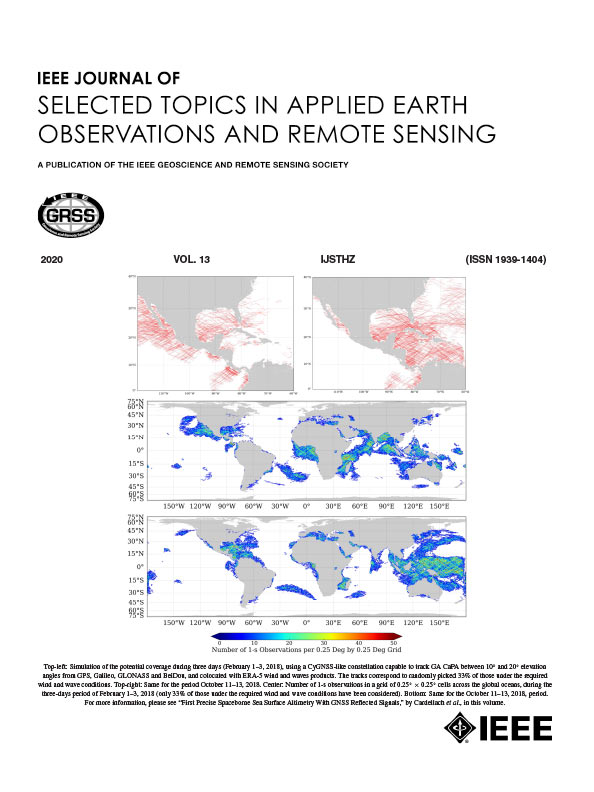An Adaptive Physical-World Adversarial Patch for Remote Sensing Image Object Detection Models Considering the Structural Characteristics
IF 5.3
2区 地球科学
Q1 ENGINEERING, ELECTRICAL & ELECTRONIC
IEEE Journal of Selected Topics in Applied Earth Observations and Remote Sensing
Pub Date : 2025-09-23
DOI:10.1109/JSTARS.2025.3613373
引用次数: 0
Abstract
Remote sensing image object detection represents a typical application in the field of remote sensing image processing. Rapid advancements in artificial intelligence have established deep learning as a prevalent method for detecting critical targets, such as aircraft, vehicles, and vessels, in remote sensing imagery. However, empirical evidence indicates that deep learning networks frequently exhibit vulnerabilities that minimal pixel perturbations in digital images can compromise their output. Adversarial attack techniques exploit this vulnerability by adding imperceptible perturbations to input data, causing erroneous outputs in deep learning models, which compromises object detection accuracy. Such attacks could be applied in military or civilian domains, such as enhancing airport security systems to prevent confidential information leaks. However, existing physical attack methods in remote sensing are limited by their lack of consideration for dynamic factors such as target characteristics and distortions. This article introduces an adaptive adversarial attack framework with emphasis on representative targets such as aircraft, which generates aircraft-attachable patches by incorporating target-specific structural characteristics. The research especially designed cross-shaped patches and improved the loss function by incorporating gradient variance loss and image quality assessment loss to enhance the physical-world transferability of the generated adversarial patches. Comprehensive validation experiments were conducted in both digital and physical domains, for which different classical object detection methods are chosen as the target models. Results demonstrate that the adversarial patch generated by our method achieve effective attacks in digital environments and can be seamlessly transferred to physical scenarios, significantly degrading detection capabilities, where the average attack effectiveness reached 32.99% in the digital domain and 62.52% in the physical domain. This substantiates the practical potential of our proposed framework and future work could extend this methodology to autonomous driving and related fields.考虑结构特征的遥感图像目标检测模型自适应物理世界对抗补丁
遥感图像目标检测是遥感图像处理领域的一种典型应用。人工智能的快速发展使深度学习成为遥感图像中检测关键目标(如飞机、车辆和船只)的普遍方法。然而,经验证据表明,深度学习网络经常出现漏洞,数字图像中的最小像素扰动可能会损害其输出。对抗性攻击技术通过在输入数据中添加难以察觉的扰动来利用这一漏洞,从而在深度学习模型中导致错误的输出,从而损害对象检测的准确性。这种攻击可以应用于军事或民用领域,例如加强机场安全系统以防止机密信息泄露。然而,现有的遥感物理攻击方法由于缺乏对目标特性和畸变等动态因素的考虑而受到限制。本文介绍了一种针对飞机等代表性目标的自适应对抗性攻击框架,该框架通过结合目标特定的结构特征来生成可附着在飞机上的补丁。该研究特别设计了十字形补丁,并通过引入梯度方差损失和图像质量评估损失对损失函数进行了改进,提高了生成的对抗补丁的物理世界可转移性。采用不同的经典目标检测方法作为目标模型,在数字和物理两个领域进行了综合验证实验。结果表明,该方法生成的对抗性补丁在数字环境中实现了有效的攻击,并且可以无缝转移到物理场景中,显著降低了检测能力,其中数字域的平均攻击效率达到32.99%,物理域的平均攻击效率达到62.52%。这证实了我们提出的框架的实际潜力,未来的工作可以将这种方法扩展到自动驾驶和相关领域。
本文章由计算机程序翻译,如有差异,请以英文原文为准。
求助全文
约1分钟内获得全文
求助全文
来源期刊
CiteScore
9.30
自引率
10.90%
发文量
563
审稿时长
4.7 months
期刊介绍:
The IEEE Journal of Selected Topics in Applied Earth Observations and Remote Sensing addresses the growing field of applications in Earth observations and remote sensing, and also provides a venue for the rapidly expanding special issues that are being sponsored by the IEEE Geosciences and Remote Sensing Society. The journal draws upon the experience of the highly successful “IEEE Transactions on Geoscience and Remote Sensing” and provide a complementary medium for the wide range of topics in applied earth observations. The ‘Applications’ areas encompasses the societal benefit areas of the Global Earth Observations Systems of Systems (GEOSS) program. Through deliberations over two years, ministers from 50 countries agreed to identify nine areas where Earth observation could positively impact the quality of life and health of their respective countries. Some of these are areas not traditionally addressed in the IEEE context. These include biodiversity, health and climate. Yet it is the skill sets of IEEE members, in areas such as observations, communications, computers, signal processing, standards and ocean engineering, that form the technical underpinnings of GEOSS. Thus, the Journal attracts a broad range of interests that serves both present members in new ways and expands the IEEE visibility into new areas.

 求助内容:
求助内容: 应助结果提醒方式:
应助结果提醒方式:


